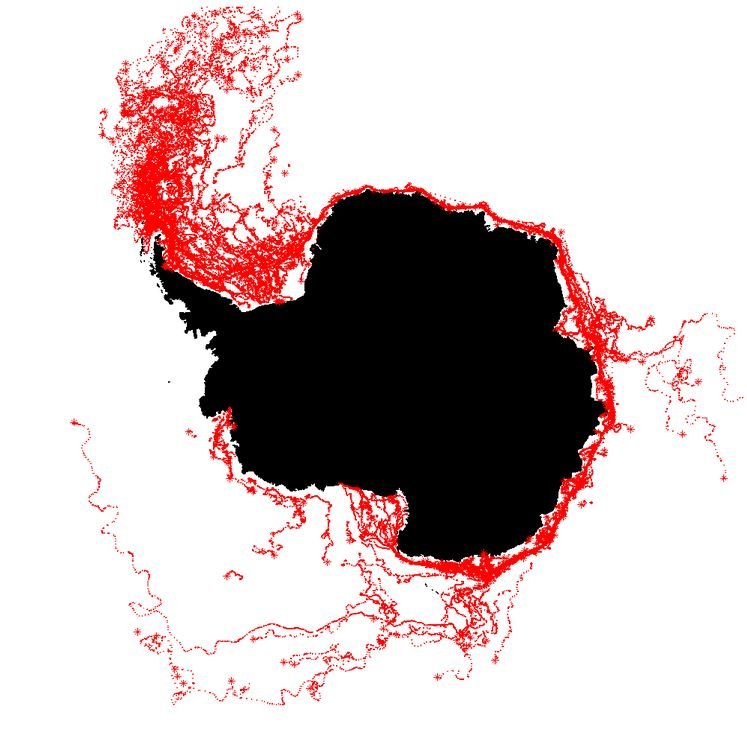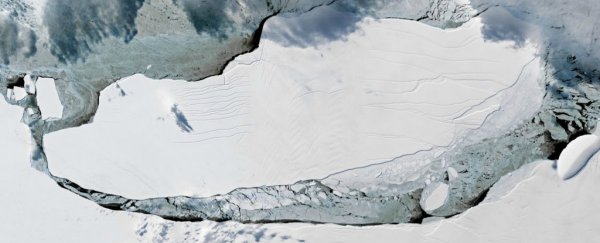One of the largest icebergs ever documented is still mostly intact one year after it broke off Antarctica, despite losing a big chunk and having its northern flank smashed to bits.
The huge ice block, called A68 or A68a, calved from the Larsen C ice shelf in July 2017.
It's hard to say exactly when A68 was born due to limited satellite coverage and thick cloud cover, but it happened sometime last year between July 10 and 12.
Scientists at the time estimated iceberg A68 to be about the size of Maryland. It measured 1,000 feet (300 metres) thick and weighed 1.1 million tons – roughly the weight of 20 million Titanic ships.
Iceberg A68 appears mostly intact today; satellites are watching as it floats in the Weddell Sea about 40 miles off the ice shelf on the Antarctic Peninsula.
However, an animation shared by the Antarctic research program Project Midas shows that the 'berg has taken a beating.
"The iceberg has been pushed around by ocean currents, tides, and winds, and its northern end has repeatedly been grounded in shallower water," the authors of a Project Midas blog post wrote on Monday.
"These groundings led eventually to further pieces of the iceberg being shattered off in May 2018. Whilst not quite large enough to be given labels themselves, the total area of icebergs lost from A-68 in May was the size of a small city."
The time-lapse animation below shows part of the Antarctic Peninsula from 12 March 2017 through 5 July 2018. You can see a huge crack in the Larsen C ice shelf creep north until the iceberg completely breaks off, then follow the path it has taken since.
"Over the last year A-68 has not drifted far because of dense sea-ice cover in the Weddell Sea," Project Midas said.
What will eventually happen to iceberg A68
Antarctic icebergs calve naturally as snow piles up, forming ultra-dense ice that gravity then drags toward the ocean.
From there, a predictable yet erratic story plays out.
 Red lines illustrate the paths of previous Antarctic icebergs. (NASA Scatterometer Climate Record Pathfinder/ESA)
Red lines illustrate the paths of previous Antarctic icebergs. (NASA Scatterometer Climate Record Pathfinder/ESA)
Most icebergs that calve from the Antarctic Peninsula get caught up in wind and water currents that drag them clockwise around the Southern Ocean as they move north.
Scientists can't be sure where iceberg A68 will ultimately float, though some think it could drift more than 1,000 miles (1,600 kilometres) north to the Falkland Islands.
The largest 'bergs can even reach South Georgia and the South Sandwich Islands before vanishing.
Martin O'Leary, a researcher at Swansea University and Project Midas, said on Reddit last year that A68 could take a couple of years to drift that far.
It could be many years before it completely melts.
In the case of B15, the second-biggest iceberg in recorded history, the process has taken nearly two decades. B15 snapped off Antarctica's Ross ice shelf in 2000.
It had a surface area of 4,200 square miles (10,800 square kilometres) – about the area of Jamaica and twice that of A68. Today it's drifting in warm waters near South Georgia.
Warmer air causes surface melt that "works its way through the iceberg like a set of knives", Kelly Brunt, a glaciologist at NASA's Goddard Space Flight Center, said in a NASA Earth Observatory post in October 2017.
"This is often the end of the life cycle of a lot of Antarctic icebergs."
Scientists continue to study and debate what caused A68 to break off, including the role of climate change driven by human activity.
"To me, it's an unequivocal signature of the impact of climate change on Larsen C," Eric Rignot, a glaciologist at NASA JPL, told CNN in July 2017.
"This is not a natural cycle. This is the response of the system to a warmer climate from the top and from the bottom. Nothing else can cause this."
This article was originally published by Business Insider.
More from Business Insider:
